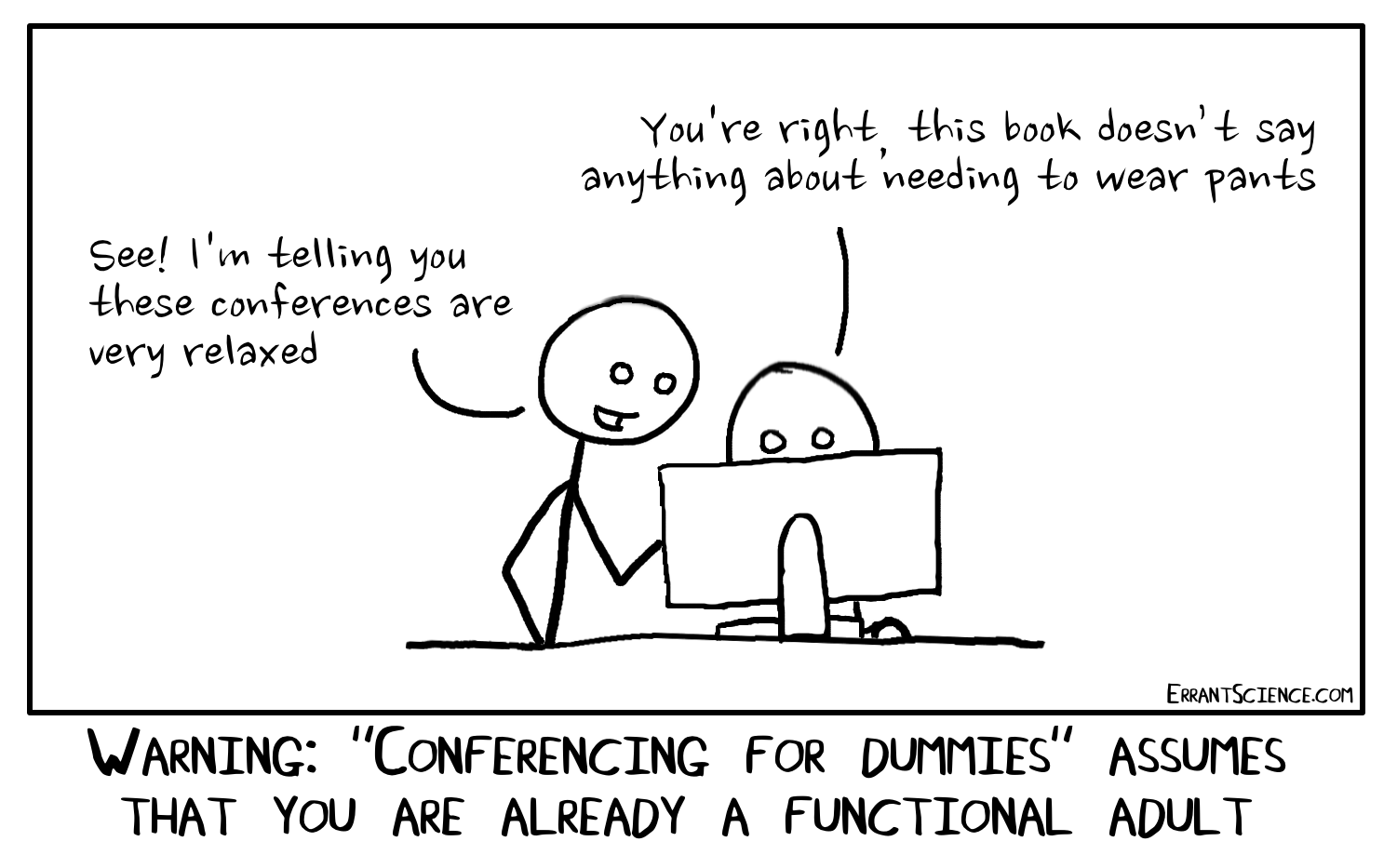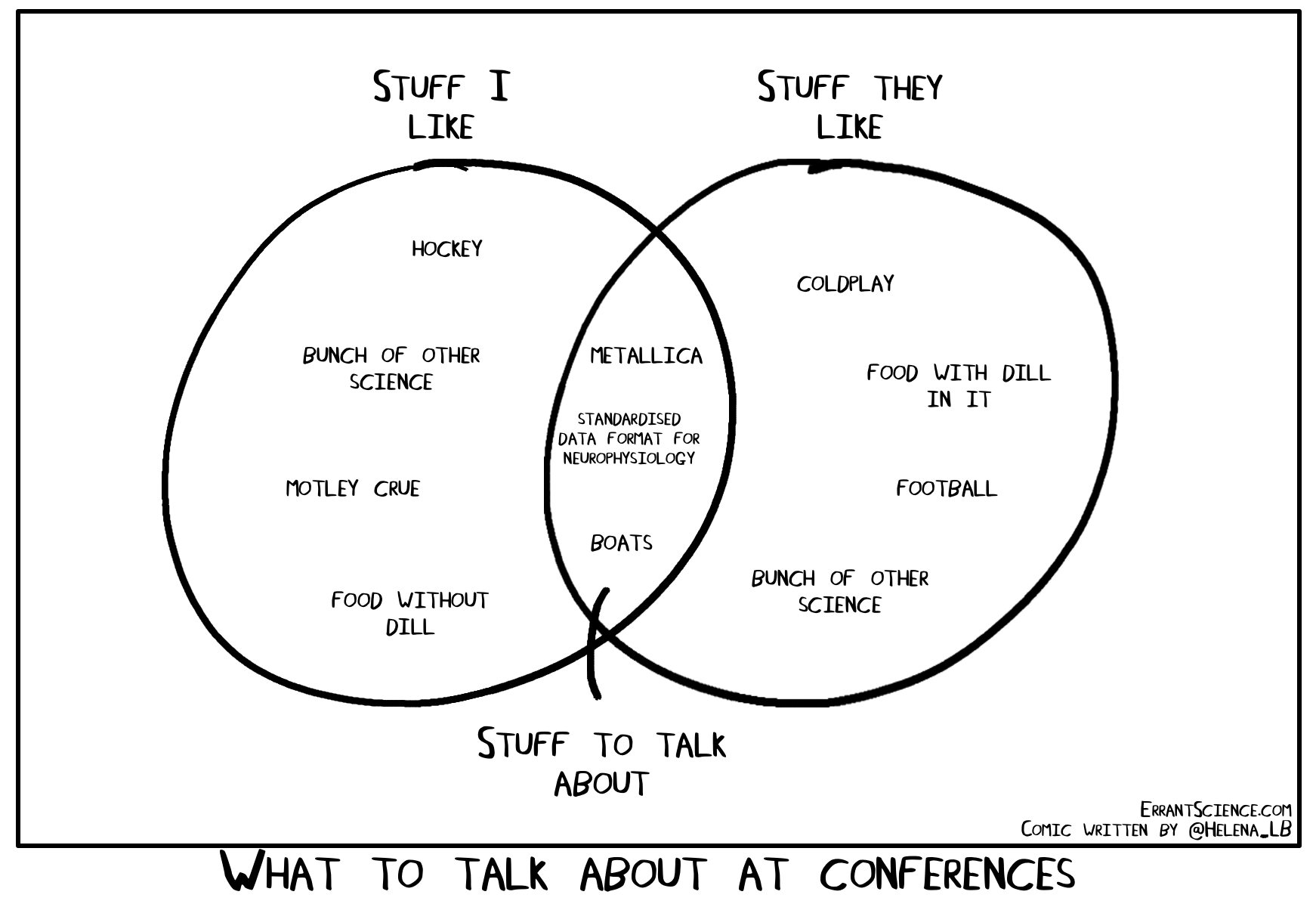The title of this post might sound harsh, but it’s exactly how I felt the first time I was at a scientific conference. I hadn’t prepared very well for attending this conference, because I was focused on presenting at this conference.
This was in 1999, and I have since then attended and/or presented at 20-something conferences, and organised almost 20 more. I’d really be a dummy if I hadn’t learned something about conferencing along the way (I think I’ve now used up my allotted number of the word “conference” and its variations).
Nowadays I attend meetings (see what I did there?) as a business developer and communicator (not as a working scientist) for incf.org, a non-profit that supports collaborative neuroscience projects regarding infrastructure, data-sharing and informatics.
There are, nevertheless, some tricks to getting the most out of a conference that are applicable no matter what your job is. If you’re of the TL;DR persuasion, there’s a bullet list at the end. But then you’ll miss the bit about Whitesnake, and boats.

Before
Goals. You should have some! If not, you’re likely to roam around, get some free stuffed toys, look at some posters that have a visually pleasing layout, catch the presidential lecture and a session with a keyword in the title that matches your project/field/job profile, and hang out at some conference-sponsored social in the evening. This is all fine, but why not set some goals and get much more out of the event?
A month or so before the meeting, you should consider the reason why you’re attending the conference (ideally you would know the reason already when you register, but usually early reasons tend to be along the lines of “they have Pastéis de Belém in Lisbon” or “Nick and Fatima are going, so…”), and list your goals. Irrespective of your specific job description, these usually fall into one or several of the following categories:
- Learn something
- Teach something
- Find a new collaborator
- Meet with existing collaborator
- Find a new job
- Hire somebody
- Sell something
- Buy something
Now, what do these eight things have in common? You have to do research in order to make any of these things happen. I believe you’re all familiar with research as a concept. What you want to research is who is going to be there – people, organisations, companies. This information can be found in the meeting programme, the list of exhibitors and sponsors, and, if you’re lucky, a participant list that’s available ahead of the meeting. If you’re desperate for a personal connection to an organisation or company that is not exhibiting, check the participant list to see if they will be hiding in plain sight as a regular attendee.
Once you’ve found the people you want to talk to, send an email and introduce yourself and enquire if you can set a time to meet during the conference. State your purpose in the email, and make sure it’s relevant for both parties. Oh! Before sending out emails or connect invites on LinkedIn, make sure that your social media profiles are up to date and delete any goofy videos of you singing Whitesnake or totally failing at setting off fireworks. (I’m just ad-libbing here, but you get my point. I would never sing Whitesnake on video.)
The next thing you need to do is prep your pitch. Why do you want to do a postdoc in this lab? Why would this company benefit from sponsoring your event? Why should this group let you use its data? (Because, unless there are anonymity issues or similar, SCIENCE WILL BENEFIT FROM DATA-SHARING.) Note that if you have several different goals, you will need as many different pitches. Because, and I’m going to say something critically important now, you have to consider your target groups. When communicating with people, make sure to talk about relevant topics. Don’t go on about your awesome science communication skills when approaching someone about being on their panel about Matlab v Python.
Anyway. There are a million sites that will teach you about the perfect elevator pitch, and it’s all basically: “If you don’t have their attention in 30 seconds, you’ve lost.” This is not entirely true, but it’s a good indication of the average human’s attention span in this situation. A great pitch will help you in ad hoc meetings – more on this later. If you, ahead of time, scheduled a meeting with someone, you already have their attention and the pressure of the pitch is much less. So make that first email count! A great email is much easier to compose than a great face-to-face pitch. Remember, less is more (she said, 767 words later).
The last thing you should do before getting on that plane/train/boat (I’ve never gone to a conference via boat, but we all know that the magic minimum number of list items is three, and buses are boring) is making sure that you have everything you need to show people, to give people, or to remember what you are going to say (download files, print cheat sheets, note cards, whatever floats your boat – I’m sticking with boats now). Don’t rely on online resources because internet access is never guaranteed.
During
In addition to your pre-arranged meetings, once at the conference, you should talk to strangers. This goes against everything your parents ever taught you, but it’s not like you ever did what they told you anyway. It’s self-explanatory, though – if you hang out only with people you already know, your network will not expand and you won’t acquire as many new opportunities. Try to balance the comfort and fun of being around people you know with randomly introducing yourself to people in the coffee line (ask if they are pro-fika for example), or find a speaker during lunch and compliment them on their talk/slides/boat (they might have had a picture of their boat on their slides, anything is possible).
The key to make people remember you is to find something you have in common. It doesn’t necessarily have to be related to your job/field/project, either – small, personal encounters can stick out in people’s minds and lead to professional growth (like @nickwan says, it’s OK to make friends!).

Another great way to connect with people is at so-called socials. Normally there are some official socials arranged by the conference organisers, and at larger meetings there are usually a number of semi- and totally un-official ones as well. All these serve their purpose. I encourage you to find as many as you can and attend as many as you have the energy for. Often you can meet important senior, otherwise very busy and hard-to-reach people at these events whom you can dazzle with your networking skills, as described above. A good place to find out about socials is on – wait for it – social media! I prefer Twitter, where you can follow the conference hashtag to find people who are attending, maybe start a group message with other attendees and so on.
After
When you get back from the conference, you need to do three things: sleep, fill out your expense claims, and FOLLOW UP. Don’t do it immediately (because everyone will have a backlog of emails, and also expense claims), but wait a week and then get to work. Send those emails, schedule those Skype calls, forward those contact details/datasets/slides (sometimes people want things from you, too).
TL;DR
- Define your goals
- Do your research
- Consider your target groups
- Find common ground
- Prep your pitch
- Make some new friends
- Follow up
Helena Ledmyr is development officer at incf.org, a non-profit organisation devoted to advancing neuroinformatics and global collaborative brain research. This article originally appeared on the blog Errant Science.
Register to continue
Why register?
- Registration is free and only takes a moment
- Once registered, you can read 3 articles a month
- Sign up for our newsletter
Subscribe
Or subscribe for unlimited access to:
- Unlimited access to news, views, insights & reviews
- Digital editions
- Digital access to THE’s university and college rankings analysis
Already registered or a current subscriber?







